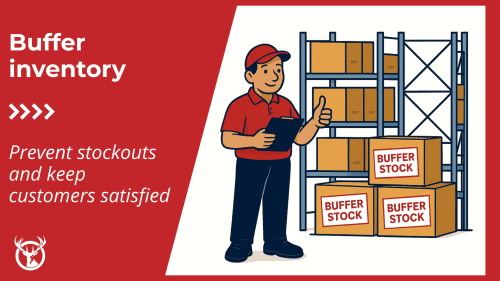What if you could choose one tool to increase your eCommerce company’s profitability? Improving your inventory management would be an excellent choice. You can use inventory management software to track the movement of products into and out of your warehouse. However, inventory software records the items you should have. It doesn’t show what you really have in stock. To find problems and keep your data accurate, you need to conduct an inventory audit.

What is an inventory audit?
An inventory audit compares your accounts to your actual inventory. You can hire an outside auditor to conduct the audit. Or your staff can perform the audit.
There are many different audit procedures. You can do a full physical count of the items in the warehouse. Or you might do partial counts, cycling through your SKUs a few at a time.
Benefits of inventory auditing for eCommerce businesses
When a brick-and-mortar shop does inventory, staff simply count all the items on the shelf. For eCommerce businesses, inventory audit procedures are a bit more complicated. You have to consider stock that is in transit to and from your fulfillment center, as well as what’s on the shelves. However, that makes inventory auditing even more important in eCommerce.
Here are three ways that conducting a regular audit will help your eCommerce business.
Identify inventory issues
Your inventory tracking software can tell you which products come into the warehouse and which are shipped out. It doesn’t always accurately record what happens in between. An audit can identify issues early before you end up with backorders.
Inventory audits will tell you if your records for a particular SKU are consistently off. Then you can find and fix the problem. Regular auditing can help you prevent inventory shrinkage.
An audit can also give you an accurate starting point for your inventory tracking app. Regular audits keep your system from accumulating and amplifying errors. Auditing is an excellent way to ensure that your financial statements are accurate.

Check the accuracy of your inventory software and processes
The best way to determine if your inventory management processes are working well is an inventory audit. Audits can help you refine your processes.
Inventory audits may seem unnecessary when your business is small. However, audits only get more challenging when your eCommerce business is more expansive. Regular inventory checks let you put good inventory management processes in place. That will benefit your company as it grows.
Gather data you need to forecast demand
Demand forecasting predicts how much stock you need to have on hand to meet demand. The better your demand forecasting, the better your inventory management. A periodic inventory audit gives you accurate data on which to base your forecasts. Anticipating future demand keeps you from tying up too much of your capital in your stock. It can also prevent you from running low during periods of high demand.
How to audit your inventory
There are many different ways to perform an inventory audit. Here are several inventory audit methods to consider for your eCommerce business.
Full physical inventory count
A complete physical inventory count is the classic way to fact check your inventory records. It involves recording every item that is on the shelves.
A cut-off analysis makes physical auditing more accurate. A cut-off analysis puts your business on pause while the count takes place. Pausing, however, can cause problems for eCommerce businesses. No orders get shipped to customers during a cut-off analysis. Some eCommerce businesses perform a physical inventory overnight to minimize disruption.
Cycle count
You don’t have to do a complete inventory count all at once. With a cycle count, your auditors check only selected products in each cycle. Eventually, you will have completed an inventory audit of your full stock. A cycle count doesn’t give you the snapshot in time the way a complete physical inventory does. However, it can still provide the actionable data you need.
Spot check inventory audit
When you do a spot check inventory audit, your auditors do a physical count of only one or two products. Checking this against your inventory records provides a window into any issues with your recordkeeping. A spot check audit can flag problems early. Doing regular spot checks can allow you to space out labor-intensive full physical inventory counts.
High-value items audit
Some eCommerce companies focus their inventory audits on high-value items. These are the products that will cost the most if the numbers are wrong. Therefore, they are worth the time and effort to conduct an inventory audit.
On the other end of the spectrum, you may want to group small and low-value items together. Grouping can save time during an inventory audit. You don’t need to count each of the loose bobbins you have in stock. Instead, you can record the weight of your supply of bobbins and extrapolate an approximate number.

ABC analysis
An ABC analysis is a method for grouping products to simplify the inventory audit. Your auditors may suggest procedures that include group products into high- and low-value cohorts.
You might also place products together by sales volume. This technique can help you prioritize your inventory audits. Products that sell more slowly probably don’t need inventory checks as often as those that move fast. An ABC analysis has the added benefit of working well with warehousing systems. Most businesses group their top sellers together for easy access during order fulfillment. Warehouse shelf position can make it easy to group them for an ABC analysis.
Inventory reconciliation
Your inventory audit may turn up discrepancies with your financial records. In that case, you’ll want to do an inventory reconciliation. It may take a bit of detective work to track down the sources and causes of the differences.
These are just a few of the generally accepted ways to audit your inventory items. There are several other auditing options. A freight analysis factors in the shipping costs that are part of your inventory costs. An overhead analysis does the same with overhead costs. If you manufacture your products, you might want to do a finished goods cost analysis. This auditing process counts only your completed stock, not the items that are in process.
Double-check your inventory audit
Your inventory audit is only as good as the data that goes into it. If you’re going to spend the time and money to conduct a physical inventory count, it’s worth doing it right.

You can improve the accuracy of your inventory audit by:
- Doubling up on your physical inventory count. Have two people count each item. Check that their numbers match. If not, recount.
- Using SKU numbers, UPC codes, or another type of barcode to track your inventory. Barcoding will improve the accuracy of your tracking every day. SKUs also make a physical inventory count more accurate. You don’t have to rely on the product knowledge of the people doing the count. They can simply scan the barcode for each item to record it correctly.
- Using more than one valuation method for your products. Conduct spot check audits in between your complete physical inventory audits.
- Consulting with a professional auditor. A third-party accounting auditor will bring best practices to your inventory audit. Also, auditors can observe your processes and give you a fresh perspective and perhaps new ideas. And you’ll save your time for other essential tasks. You can alternate internal and external audits to reduce the cost.
Ways to improve your inventory management
Regular inventory audits are a great way to improve your inventory processes. And software that allows you to track and manage your inventory will help you run your business more efficiently.
Another great way to improve your inventory management might surprise you: outsource your eCommerce fulfillment. The professionals at a third-party logistics company can help you reduce breakage. Third-party stock management can also help you increase the accuracy of your financial records and eliminate “ghost” stock. For example, at Red Stag Fulfillment, we have a zero shrinkage policy, so you never lose items from our shelves. Also, our experienced staff can help you set optimal inventory levels. Feel free to give us a call. We’d like to help you reduce the cost of inventory for your eCommerce business.








